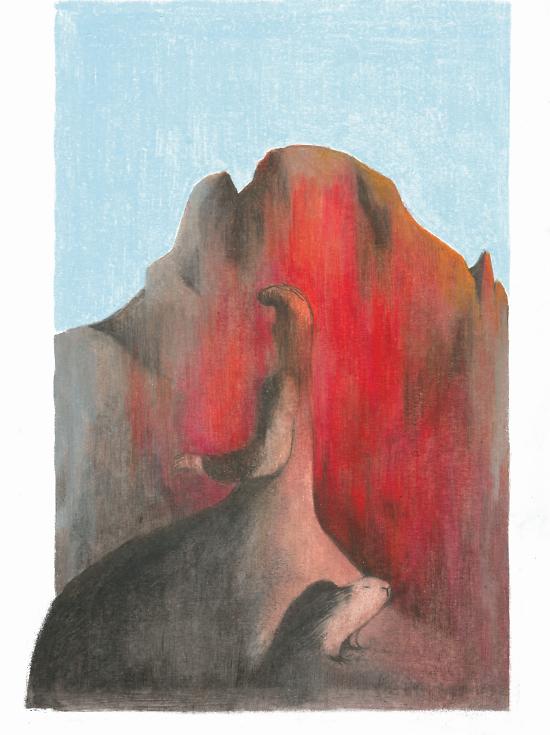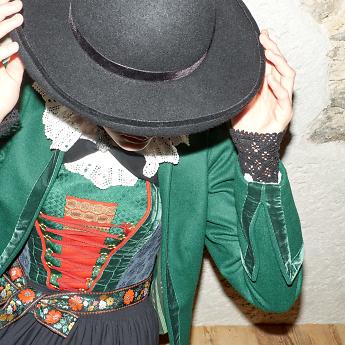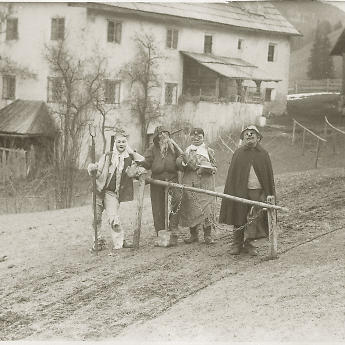
The Red Mountain
Legends that need to be read
One silent night many centuries ago, young Moltina was watching over her newborn baby who, as often happens with children, found it difficult to go to sleep. When silence finally descended on the valley, she heard a mysterious sound and decided to go out into the deep dark night, where the moonlight illuminated the majestic peaks of the mountains and the wind blew gently from the west.
Suddenly, the air was filled with a strange and disturbing noise. Frightened, Moltina ran to wake up her husband, the prince of the Landrins. He listened carefully and after hearing the sound himself, he said “Take the child and go and hide somewhere safe, because that is the clang of weapons and the stamping and pounding of men and horses in armour; an entire army is approaching”.
So Moltina and her little one turned themselves into marmots and went and hid in a narrow crevice in the mountain, where they found that other rodents were already hiding. In the meantime, the prince moved some huge rocks to close the entrance and prepared to defend them.
The night passed in silence and in the morning when the sun rose, everyone came out of their hiding place. There was no sign of any army, so the marmots sat on the rocks and joyfully greeted the arrival of the day. The mountain, as if by magic, was tinged with red, reflecting the heat of the rising sun.
In the afternoon, the prince went to Popéna to speak to his subjects and tell them about the night's event. But since there had been peace for a long time, no-one believed him. The prince insisted, warning everyone of the possible threat, and urged them to be vigilant. Then he returned to Croda Rossa.
The following night, the mysterious noise returned. The prince followed the sound and came to a clearing where he saw soldiers on foot and on horseback training under the moonlight. He noticed, however, that they were inexperienced, with ill-matched weapons and horses. After a while, the groups dispersed and lit campfires to rest for the night.

The prince approached one of these fires and learned that they were the Fànes, a people who lived far away. They welcomed him warmly and told him that they had fled from the vast eastern plain to take refuge in the mountains, where they lived in peace. But now, having learned of an imminent attack by foreigners, they were preparing to defend themselves and so they trained at night, on the eastern border of their territory.
The prince then offered them advice on weapons and military tactics and seeing his experience, wisdom and expertise, the Fànes begged him to return to lead them in their training. Soon, he became their commander and, when the time for battle came, he led them to victory.
When they returned, the Fànes paid homage to the prince, raising him up before the people and proclaiming him king and the following year, they built a castle for him on the Conturìnes. Before taking up residence with his queen, the new king had a marmot painted on the main wall of the castle, and from then on all the Fànes carried the image of the marmot on their shields.
The kingdom of the Fànes grew in power and prestige and the Croda Rossa soon became part of the kingdom, which extended from the great cliffs of Wanna to the jagged mountains of Bedoyères and Landrínes.
One day, the king and queen visited old Anguàna on the Croda Rossa and told her about their exploits. The old woman replied “You will be the forefathers of a dynasty that will bring unexpected prosperity to the kingdom of the Fànes and which for long periods will surpass all the other ruling houses in fame and honor.”
Then she asked Moltina if she had ever visited her husband's castle in the Popéna valley. Embarrassed, Moltina confessed that she had always been held back by an overwhelming shyness.
“If that's so” said Anguàna, “the mountain we're on will be red forever!” And so it was.
Karl Felix Wolff was born in 1879 in Karlstadt (now Karlovac, Croatia) to an Austrian officer originally from Troppau and a mother from a noble Ladin family from the Nonsberg. Raised without a traditional school education, he was educated by his father and trained as a self-taught ethnologist. From 1881 he lived in Bolzano until his death in 1966. A journalist by profession, Wolff is known for his work in collecting and transcribing the Ladin legends of the Dolomites, published in 1913 with the title “Dolomiten-Sagen”. Although based on authentic popular traditions, these stories were rewritten by Wolff in order to convey the atmosphere and spirituality of the Dolomite valleys. In 1960 he received the Walther-von-der-Vogelweide-Award for his contribution to Ladin culture and his personal archives are kept at the University of Innsbruck Brenner-Archiv.








































